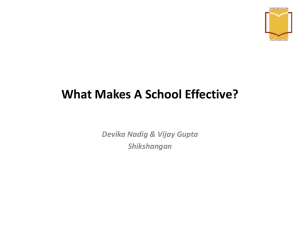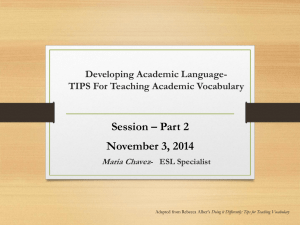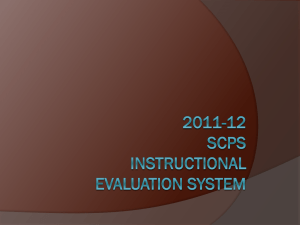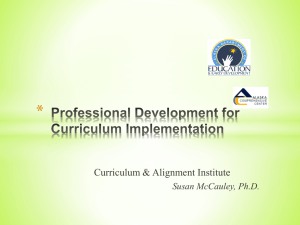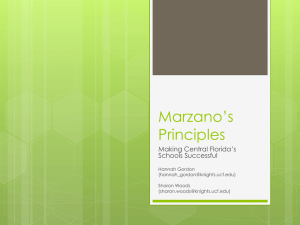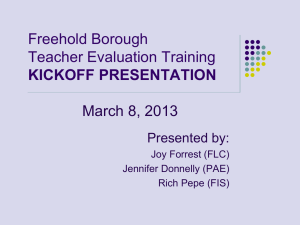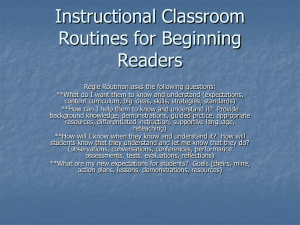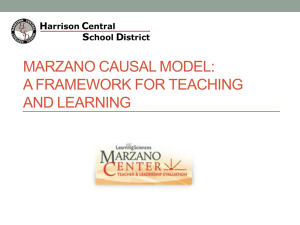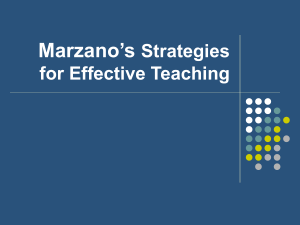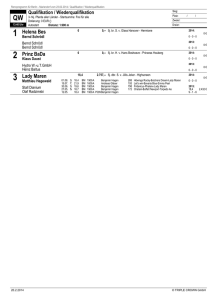Balanced Leadership: School Leadership That Works™
advertisement
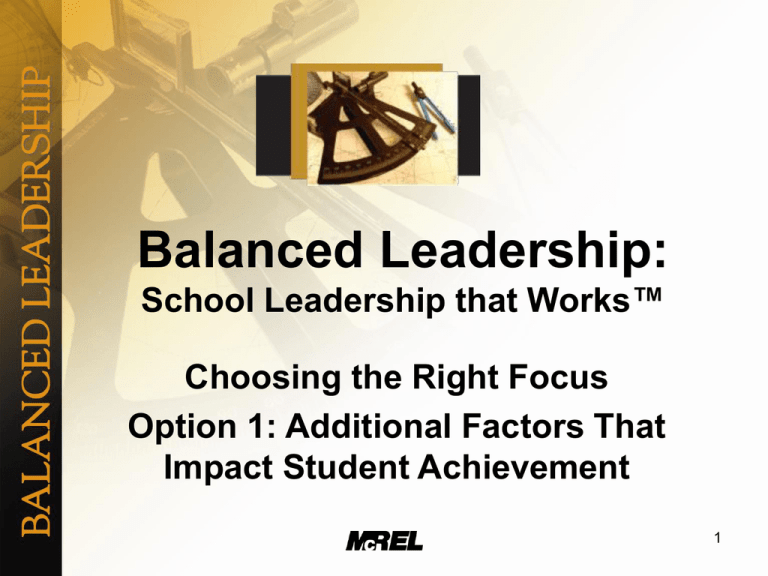
Balanced Leadership: School Leadership that Works™ Choosing the Right Focus Option 1: Additional Factors That Impact Student Achievement 1 Session outcomes 1. Understanding of the relationship between choosing the right focus and student achievement. 2. Understanding of research-based school and classroom practices and student-level characteristics and how they relate. 3. Increased knowledge about researchbased leadership responsibilities associated with choosing the right focus. 4. Understanding of the importance of alignment. 2 Overview • • • • • • • • Welcome back, Community Circle Parent & Community Involvement Safe and orderly Environment Collegiality and Professionalism Instructional Strategies Classroom Management Home Environment Student Motivation 3 Responsibilities primarily associated with focus of change (p.7) • • • • Contingent Rewards Discipline Focus Involvement in Curriculum, Instruction, Assessment • Order • Outreach • Resources 4 Influences on student learning (p.8) LEADERSHIP Classroom Student 1. 2. 3. 4. 5. Guaranteed and Viable Curriculum Challenging Goals and Effective Feedback Parent and Community Involvement Safe and Orderly Environment Collegiality and Professionalism 6. 7. 8. Instructional Strategies Classroom Management Classroom Curriculum Design 9. Home Environment 10. Learned Intelligence/Background Knowledge 11. Motivation LEADERSHIP LEADERSHIP School LEADERSHIP 5 Research-based school practices What Works in Schools (practices) A New Era of School Reform (factors) Guaranteed and Viable Curriculum • Alignment • Time Challenging Goals and Effective Feedback • Monitoring • Pressure to Achieve Parent and Community Involvement • Parent Involvement Safe and Orderly Environment • School Climate Collegiality and Professionalism • Communication and Decision Making • Cooperation (Marzano, 2000a; 2003) 6 School-level practices (p.18) AVERAGE EFFECT SIZE PERCENTILE GAIN Alignment 0.88 31 Time 0.39 15 Monitoring 0.30 12 Pressure to Achieve 0.27 11 Parental Involvement 0.26 10 School Climate 0.22 8 Communication and Decision Making 0.10 4 Cooperation 0.06 2 SCHOOL FACTORS (Marzano, 2000a) 7 School-level practices (p.26) • Guaranteed and Viable Curriculum • Challenging Goals and Effective Feedback • Parent and Community Involvement • Safe and Orderly Environment • Collegiality and Professionalism (Marzano, 2003) 8 Parent and community involvement (p.26) Parental involvement – the extent to which parents are involved in and supportive of the culture and operating procedures of the school (Marzano, 2003) 9 Parent and community involvement (p.27) • • • Parents are invited and genuinely encouraged to become involved in the school. Parents are involved as classroom aides, monitor school activities, and are used as expert resources in classrooms. Parents are included in school-level governance processes and decisions when appropriate. 10 Family Involvement Research shows that family involvement results in: 1. 2. 3. 4. 5. Higher grades Better attendance More positive attitudes toward school Higher graduation rate Greater enrollment in college (Henderson and Berla, 2004) 11 National PTA Standards 1. Meaningful, two-way communication between home and school 2. Parenting Skills are promoted and supported 3. Parents assist their children in learning 4. Volunteering 5. Parents are involved in school-based decision making and advocacy 6. Community resources support schools, families and learning (Joyce Epstein) 12 School-level practices (p.27) AVERAGE EFFECT SIZE PERCENTILE GAIN Alignment 0.88 31 Time 0.39 15 Monitoring 0.30 12 Pressure to Achieve 0.27 11 Parental Involvement 0.26 10 School Climate 0.22 8 Communication and Decision Making 0.10 4 Cooperation 0.06 2 SCHOOL FACTORS (Marzano, 2000a) 13 Parent & Community Involvement Action Steps 1. Establish vehicles for communication between schools and parents and the community. All communications should be issued in the major languages of the school’s linguistically diverse students. Phone calls, Parent-Teacher-Student Conferences, Internet 14 Parent & Community Involvement Action Steps 2. Establish multiple ways for parents and community to be involved in the day-today operations of the school. Classroom aides, hallway monitors, clerical assistants, guest lecturers Volunteer programs 15 Parent & Community Involvement Action Steps 3. Establish governance vehicles that allow for the involvement of parents and community members. School improvement (leadership) teams, other structures 16 Table Talk How are parents involved in your school… as partners in their own child’s learning? as volunteers? in school governance? Which leadership responsibilities are most important in managing parent involvement at your school? 17 School-level practices (p.28) • Guaranteed and Viable Curriculum • Challenging Goals and Effective Feedback • Parent and Community Involvement • Safe and Orderly Environment • Collegiality and Professionalism (Marzano, 2003) 18 Safe and orderly environment (p.28) School climate – the extent to which a school creates an atmosphere that students perceive as orderly and supportive (Marzano, 2003) 19 Safe and orderly environment (p.29) • Students and teachers know and understand expected behaviors. • Consequences are clear, fair, and consistently applied. • Students are taught self-discipline and to assume responsibility for the quality of the learning environment. 20 School-level practices (p.29) AVERAGE EFFECT SIZE PERCENTILE GAIN Alignment 0.88 31 Time 0.39 15 Monitoring 0.30 12 Pressure to Achieve 0.27 11 Parental Involvement 0.26 10 School Climate 0.22 8 Communication and Decision Making 0.10 4 Cooperation 0.06 2 SCHOOL FACTORS (Marzano, 2000a) 21 Safe and Orderly Environment Action Steps 1. Establish rules and procedures for behavioral problems that might be caused by the school’s physical characteristics or the school’s routines. Prevention strategies 22 Safe and Orderly Environment Action Steps 2. Establish clear school-wide rules and procedures for general behavior. Communicate rules and procedures to students in a highly visible manner. 23 Safe and Orderly Environment Action Steps 3. Establish and enforce appropriate consequences for violations of rules and procedures. 24 Safe and Orderly Environment Action Steps 4. Establish a program that teaches selfdiscipline and responsibility to students. 25 Safe and Orderly Environment Action Steps 5. Establish a system that allows for the early detection of students who have high potential for violence and extreme behaviors. 26 Table Discussion How are you creating a safe and orderly environment at your school? Which leadership responsibilities do you use? Consider how you (1) establish schoolwide rules and procedures, (2) determine and apply appropriate consequences for violation of rules, (3) teach students self-discipline, and (4) identify students at risk for violence or extreme behavior. 27 School-level practices (p.30) • Guaranteed and Viable Curriculum • Challenging Goals and Effective Feedback • Parent and Community Involvement • Safe and Orderly Environment • Collegiality and Professionalism (Marzano, 2003) 28 Collegiality and professionalism (p.30) Communication and decision making – the extent to which the school leader is an information provider and facilitates group decision making Cooperation – the extent to which staff members in a school support one another by sharing resources, ideas, and solutions to common problems (Marzano, 2003) 29 Collegiality and professionalism (p.31) • Norms and standards for professional conduct are formalized and modeled by teachers and staff. • Effort and quality performance are the basis for recognition. 30 School-level practices (p.31) AVERAGE EFFECT SIZE PERCENTILE GAIN Alignment 0.88 31 Time 0.39 15 Monitoring 0.30 12 Pressure to Achieve 0.27 11 Parental Involvement 0.26 10 School Climate 0.22 8 Communication and Decision Making 0.10 4 Cooperation 0.06 2 SCHOOL FACTORS (Marzano, 2000a) 31 Professionalism & Internal Accountability • “Schools do not ‘succeed’ in responding to external cues or pressures unless they have their own internal system for reaching agreement evident in organization and pedagogy…they have a strong internal focus on issues of instruction, student learning and expectations for teacher and student performance.” -- Richard Elmore (2004) 32 Internal Accountability • “…there is a high degree of alignment among individual teachers about what they can do and about their responsibility for the improvement of student learning. Such schools also have shared expectations among teachers, administrators and students about what constitutes good work and a set of processes for observing whether these expectations are being met.” (Richard Elmore, 2004) Expectations, individual responsibility to act, and accountability are aligned and collectively held and reinforced= internal accountability. 33 School Climate Audit 34 Classroom-level practices (p.42) • Instructional Strategies • Classroom Management • Classroom Curriculum Design (Marzano, 2003) 35 Nine categories of instructional strategies (p.43) Effect Size Percentile Gain Identifying similarities and differences 1.61 45 Summarizing and note taking 1.00 34 Reinforcing effort and providing recognition 0.80 29 Homework and practice 0.77 28 Nonlinguistic representations 0.75 27 Cooperative learning 0.73 27 Setting goals and providing feedback 0.61 23 Generating and testing hypotheses 0.61 23 Activating prior knowledge 0.59 22 Category (Marzano, 2000a) 36 Research-based instructional strategies (p.43) • Research-based instructional strategies, classroom management, and curriculum design is the primary focus of school improvement. • Ongoing professional development enhances teachers’ use of researchbased instructional strategies, curriculum design, and classroom management practices. 37 Modified jigsaw (p.44) In teams of three: 1. Become an expert on three instructional categories. 2. Share the key ideas for the assigned instructional categories. 3. Illustrate effective uses of the key ideas with classroom examples. 38 Small-group debrief (p.59) 1. How would you help teachers gain expertise in these instructional categories? 2. How would you monitor these instructional categories? 39 What is classroom curriculum design? • Classroom curriculum design is…. • The sequencing and pacing of content along with the experiences students have with content. • Under the purview of the classroom teacher. • Based on a guaranteed and viable curriculum. 40 Curriculum Sequence Guide Grade Level: Subject/Course: Standard Benchmarks Declarative Procedural 9 weeks Time Frame Instructional Practices/Strategies Required Setting Objectives Providing Feedback Reinforcing Effort Key Vocabulary Terms/Phrases 9 weeks 9 weeks Recommended Research-Based Strategy □ □ □ □ □ □ □ □ □ □ 9 weeks Other Strategies Comparison Classification Summarizing Note taking Graphic organizers Questions Cues Advance organizers Decision-making Problem solving Assessment Methods □ □ □ □ True/False Multiple Choice Essay Performance □ Constructed Response □ Personal Communication □ Teacher Observation □ Oral Reports □ Student Self-Assessment Resources 41 Instructional Sequence Framework Determining a focus for learning Activating background knowledge Learning new content Extending and refining knowledge Classroom Curriculum Design Learning is enhanced when a teacher identifies types of knowledge that are the focus for the lesson or unit Learning requires engagement in tasks that are structured or are sufficiently similar to allow for effective transfer of knowledge Learning requires multiple exposures to and complex interactions with knowledge Learning requires complex interactions with knowledge Classroom Instruction that Works Learning is enhanced when a teacher identifies the specific types of knowledge that are the focus of the lesson or unit Learning requires engagement in tasks that are structures or are sufficiently similar to allow for effective transfer of knowledge Learning requires multiple exposures to knowledge Declarative Procedural Non-linguistic Homework & representations practice o Graphic organizers Model steps & o Mnemonics provide written o Physical & steps pictographic Think aloud representations Mental Cues, questions, & rehearsal advance organizers Graphic SQ3R organizer Advanced organizer Feedback Summarizing Massed & Note-taking distributed Three minute pause practice Reciprocal teaching Chart accuracy & KWL speed Vocabulary Similarities & Differences Summarizing & note-taking Homework & practice Questions Analyzing errors Analyzing perspectives Constructing support Induction & Deduction Classification Comparison Analogies Dimensions of Learning Setting objectives Feedback Effort Recognition Types of knowledge: -declarative -procedural Attitudes and perceptions Cues, questions& advance organizers Cooperative learning Non-linguistic representations Vocabulary Attitudes and perceptions Using knowledge meaningfully Generating & testing hypotheses Summarizing Recognition Decision making Investigation Experimental inquiry Problem solving Invention System Analysis Attitudes and perceptions 42 Classroom curriculum design (p.60) Learning is enhanced when teachers identify important declarative and procedural knowledge. Learning requires tasks that are structured for effective transfer of knowledge. Learning requires multiple exposure to and complex interactions with knowledge tasks that are structured for effective transfer of knowledge. (Marzano, 2003) 43 Classroom Management “Classroom Management is the confluence of teacher actions in 4 distinct areas: (1) establishing and enforcing rules and procedures, (2) carrying out disciplinary actions, (3) maintaining effective teacher and student relationships, and (4) maintaining an appropriate mental set for management.” (Marzano, 2003) 44 Effects of Disciplinary Techniques on Classroom Behavior Technique Average Effect Size Number of Effect Sizes Percent Decrease in Disruptive Behavior Reinforcement 0.86 101 31 Punishment 0.78 40 25 No immediate consequence 0.64 70 24 Punishment and Reinforcement 0.97 12 33 Source: Stage, S.A. & Quiroz, D.R. (1997). A meta-analysis of interventions to decrease disruptive classroom behavior in public education settings. School Psychology Review, 26 (3) 333-368. 45 Teacher-Student Relationships “ Briefly, teachers should be effective instructors and lecturers, as well as friendly, helpful and congenial. They should be able to empathize with students, understand their world, and listen to them. Good teachers are not uncertain, undecided, or confusing in the way they communicate with students. They are not grouchy, gloomy, dissatisfied, aggressive, sarcastic, or quicktempered. They should be able to set standards and maintain control while still allowing students responsibility and freedom to learn.” (Wubbels, Brekelmans, van Tartwijk, & Admiral, 1999) 46 Appropriate Mental Set The appropriate mental set for a classroom teacher has two essential and distinguishing features: (1) Withitness (the disposition of the teacher to quickly and accurately identify problem behavior and act on it) (2) Emotional Objectivity (implements and enforces rules and procedures, executes disciplinary actions and cultivates effective relationships with students without becoming upset if students violate classroom rules and procedures.) 47 Classroom Management Action Steps 1. Have teachers articulate and enforce a comprehensive set of classroom rules and procedures. 2. Have teachers use specific strategies that reinforce appropriate behavior and recognize and provide consequences for inappropriate behavior. 3. Institute a schoolwide approach to discipline. 4. Help teachers develop a balance of moderate dominance and moderate cooperation in their dealings with students. 48 Classroom Management Action Steps, cont. 5. Provide teachers with an awareness of the needs of different types of students and ways of alleviating those needs. (Five different types of students: Passive, Aggressive, Attention Problems, Perfectionist, Socially rejected) 6. Have teachers employ specific strategies to maintain or heighten their awareness regarding the actions of students in their classes (“withitness”). 7. Have teachers employ specific strategies that help them maintain a healthy emotional objectivity with their students. 49 Table Talk Consider the elements of a purposeful community: outcomes that matter to all, agreed upon processes, use of all assets and collective efficacy, and how they might be used to enhance teachers’ classroom management skills in your building. Identify key leadership responsibilities you would use to improve teachers’ classroom management skills. 50 Student-level characteristics (p.61) • Home Environment • Learned Intelligence and Background Knowledge • Student Motivation (Marzano, 2003) 51 Factors Associated with SES Factor Correlation PAV Income .315 9.92% Education Occupation Home atmosphere 52 Factors Associated with SES Factor Correlation PAV Income .315 9.92% Education .185 3.24% Occupation Home atmosphere 53 Factors Associated with SES Factor Correlation PAV Income .315 9.92% Education .185 3.24% Occupation .201 4.04% Home atmosphere 54 Factors Associated with SES Factor Correlation PAV Income .315 9.92% Education .185 3.24% Occupation .201 4.04% Home atmosphere .577 33.29% 55 Home Environment A school cannot change the income, education, or occupation of adults in the home, but it can have a potential impact on the atmosphere in the home. “The average correlation between home environment and student achievement is 0.33, indicating that the home environment accounts for 10.89 percent of the variance in student achievement.” (Fan and Chen, 2001) 56 Home Environment Three elements of home environment: (1) communication about school, (average correlation between this element and academic achievement = 0.17) (2) supervision, (average correlation with academic achievement= 0.13), and (3) parental expectations and parenting styles (average correlation with academic achievement = 0.39) 57 Home Environment Action Step 1. Provide training and support to parents to enhance their communication with their children about school, their supervision of their children (homework), and their ability to communicate expectations to their children within the context of an effective parenting style. 58 Learned intelligence and background knowledge (p.61) Crystallized intelligence – learned knowledge about the world Background knowledge – prior knowledge about a specific domain Learned intelligence can be enhanced through vocabulary instruction. (Marzano, 2003) 59 Three actions for learned intelligence and background knowledge (p.62) 1. Increase the number and quality of life experiences students have. 2. Emphasize vocabulary through wide reading. 3. Provide direct vocabulary instruction in specific content areas. (Marzano, 2003) 60 Vocabulary link (p.63) Discipline Contingent Reward Outreach 61 Student Motivation • “ We have forgotten many important truths about human motivation. Study after study confirms that people are motivated by work that provides growth, recognition, meaning, and good relationships…we want to learn…And, we need to be involved in decisions that affect us.” Margaret Wheatley, p. 151 Finding Our Way: Leadership for an Uncertain Time 62 Student Motivation Drive Theory: Success oriented vs. Failureavoidant Attribution Theory: How students perceive the causes of their prior successes and failures is a better determinant of motivation and persistence (ability, effort, luck, task difficulty) Self-worth Theory: Based on the premise that the search for self-acceptance is one of the highest human priorities. Emotions: Play a prominent role in motivation Self-system: Houses deeply seated needs and aspirations (Maslow’s hierarchy-Basic Needs, Personal Safety, Social needs, Esteem/Self-respect, Self actualization) 63 Student Motivation Action Steps 1. Provide students with feedback on their knowledge gain (individual progress as opposed to competitive standing). 2. Provide students with tasks and activities that are inherently engaging (tap into their passions). 3. Provide opportunities for students to construct and work on long term projects of their own design. 4. Teach students about the dynamics of motivation and how those dynamics affect them. 64 Guided reflection (p.65) In your Participant’s Manual: 1. Think about what you learned about school-, classroom-, and studentlevel influences on achievement. 2. Using McREL’s knowledge taxonomy, describe how what you learned will add to your knowledge base. 65
